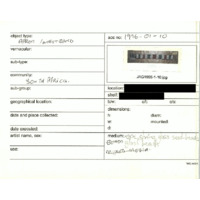Catalogue card JAG 1996-1-10
Metadata
Catalogue card JAG 1996-1-10
[ Source of title : FHYA using JAG catalogue card ]
Object
Textual record
JAG 1996-1-10
Creative Commons License: CC BY-NC-ND https://creativecommons.org/licenses/by-nc-nd/4.0/
Description [Source - Debra Pryor for FHYA, 2022, using spreadsheet created by Nessa Leibhammer for the South African Heritage Resources Information System (SAHRIS), from JAG materials in 2015: Object description: Ten rolled waistbelt. Beading is wrapped around rolls of textile joined together to form a long flat rectangular belt. Each roll has strands of string projecting from their ends embellished with 2 larger red beads at each string. The panel has a lacy fringe and a small beadwork flap at its left hand side. It is divided up into 16 vertical panels of alternating colours the last section being 3 vertical rows of 7 white Xs on a black background. Object form type: apron/waistband; Object material type: beads, mixed media; Technique: Beading; Colours: Red, black, white, green; Object age: late 19th/early 20th century; Production place: KwaZulu-Natal; Cultural association: Southern Nguni; Place of use: Eastern Cape; Provenance: .]
Attributions and conjectures [Source - Nessa Leibhammer for FHYA, 2017: Comments on classification: In his 'A Preliminary Survey of the Bantu Tribes of South Africa', Union of South Africa, Department of Native Affairs, Ethnological Publications, Vol. 5, Pretoria, Government Printer, (1935): 7, 70-83, national government ethnologist, Nicholas Van Warmelo did not use the term "North Nguni". He grouped people living both north and south of the Thukela, under one umbrella term, "Natal Nguni", based on linguistic affinity. His classification was adapted by the ethnology curator, Margaret Shaw, in her 1958 "System of Cataloguing Ethnographic Material in Museums" which determined that items from the region were to be classified as "Natal Nguni: Zulu and others (not differentiated)." According to art historian, Anitra Nettleton, the classificatory system used by art galleries and museum shifted from Shaw's model to the one where "Natal Nguni" fell away and was replaced by "North/Northern Nguni" for KwaZulu-Natal and Swaziland because scholars found it difficult to distinguish items from adjacent areas, or emigrant people from those from the KZN region. Scholars working with the JAG materials used broad ethno-linguistic categories (Zulu, Xhosa, Tsonga, Shona, Sotho, Tswana) to identify the makers/users of the objects, all of which came to JAG without much by way of provenance, and identification was based on factors such as object type, materials, formal composition, style and surface patterning (emails A. Nettleton to N. Leibhammer, 25 and 28 November 2014).]
| Event Actor | Event Type | Event Date | Event Description |
|---|---|---|---|
| Five Hundred Year Archive (FHYA) | Online curation | 2023- | |
| Johannesburg Art Gallery (JAG) | Custody | 1996- | |
| Johannesburg Art Gallery (JAG) | Making | c.1996 |
If you have difficulty accessing the objects, use these links.

Contributions